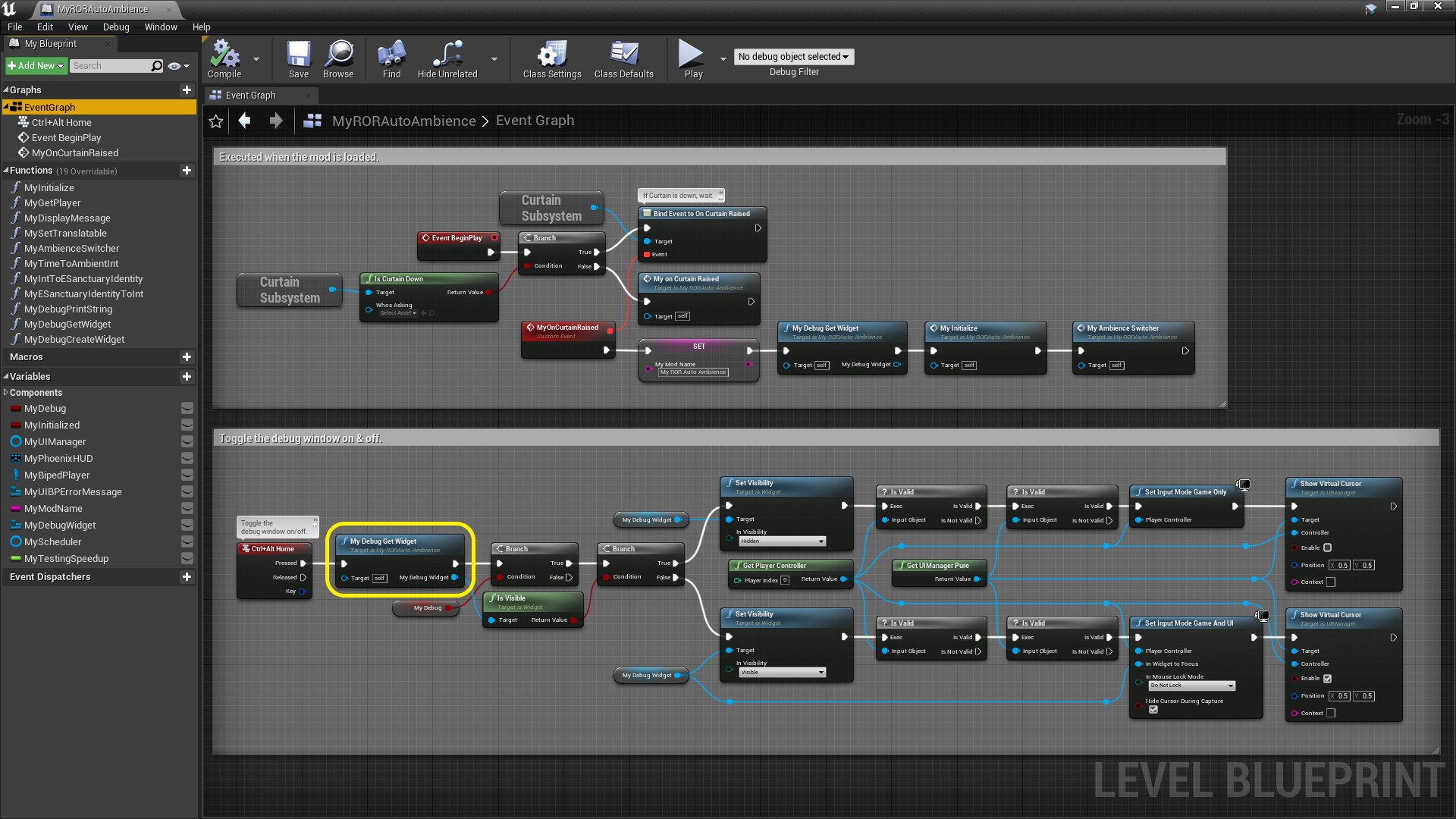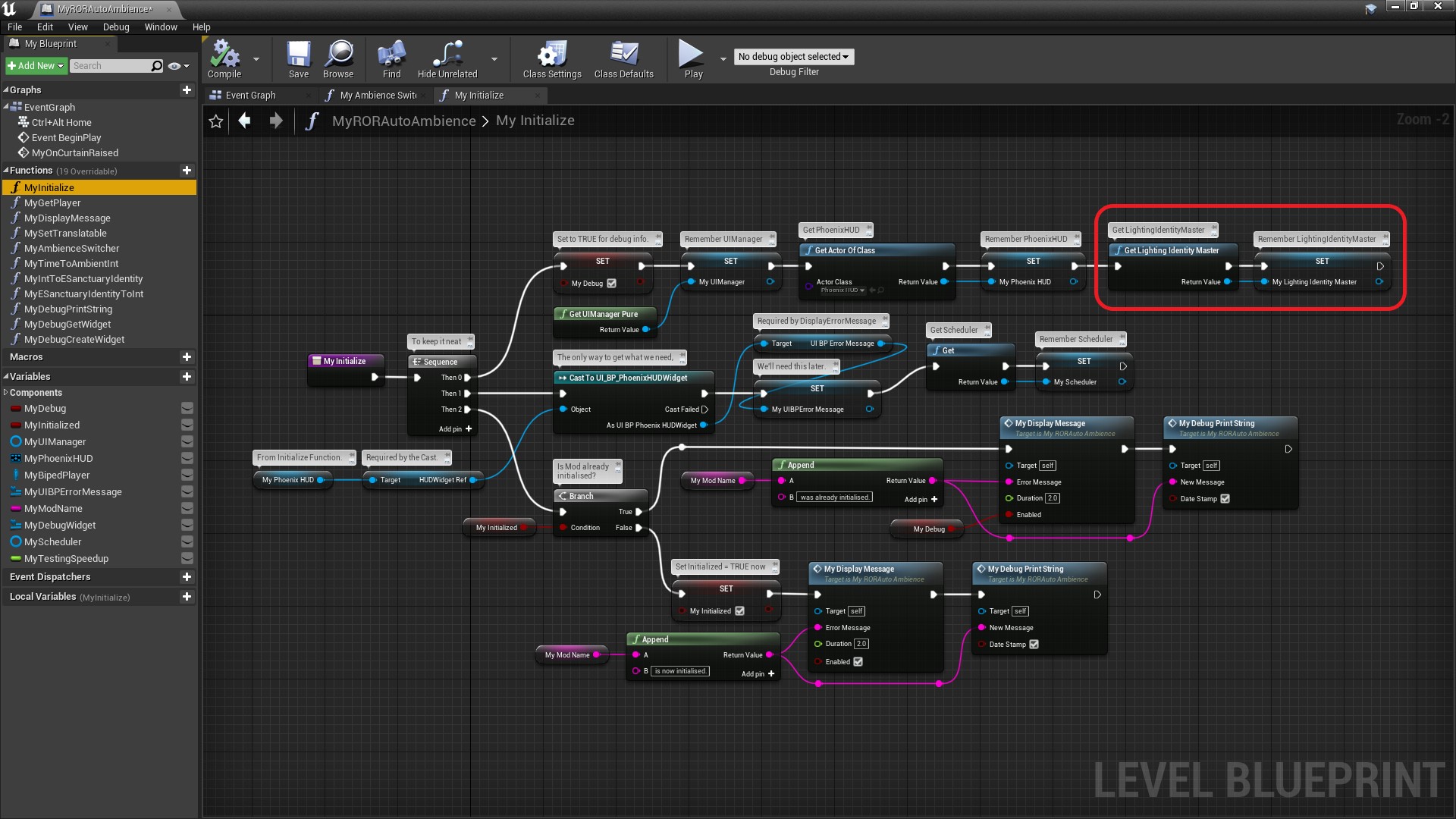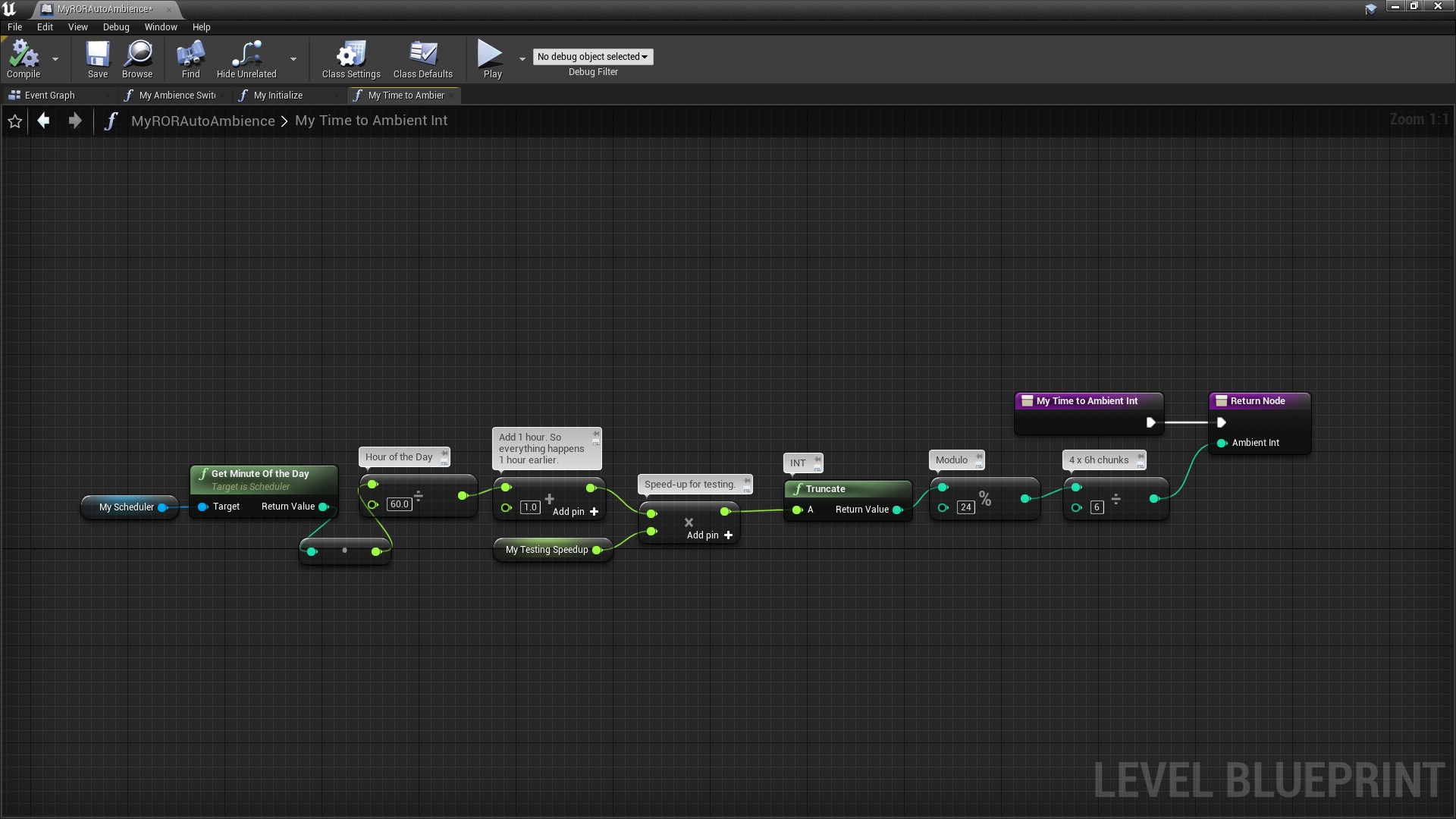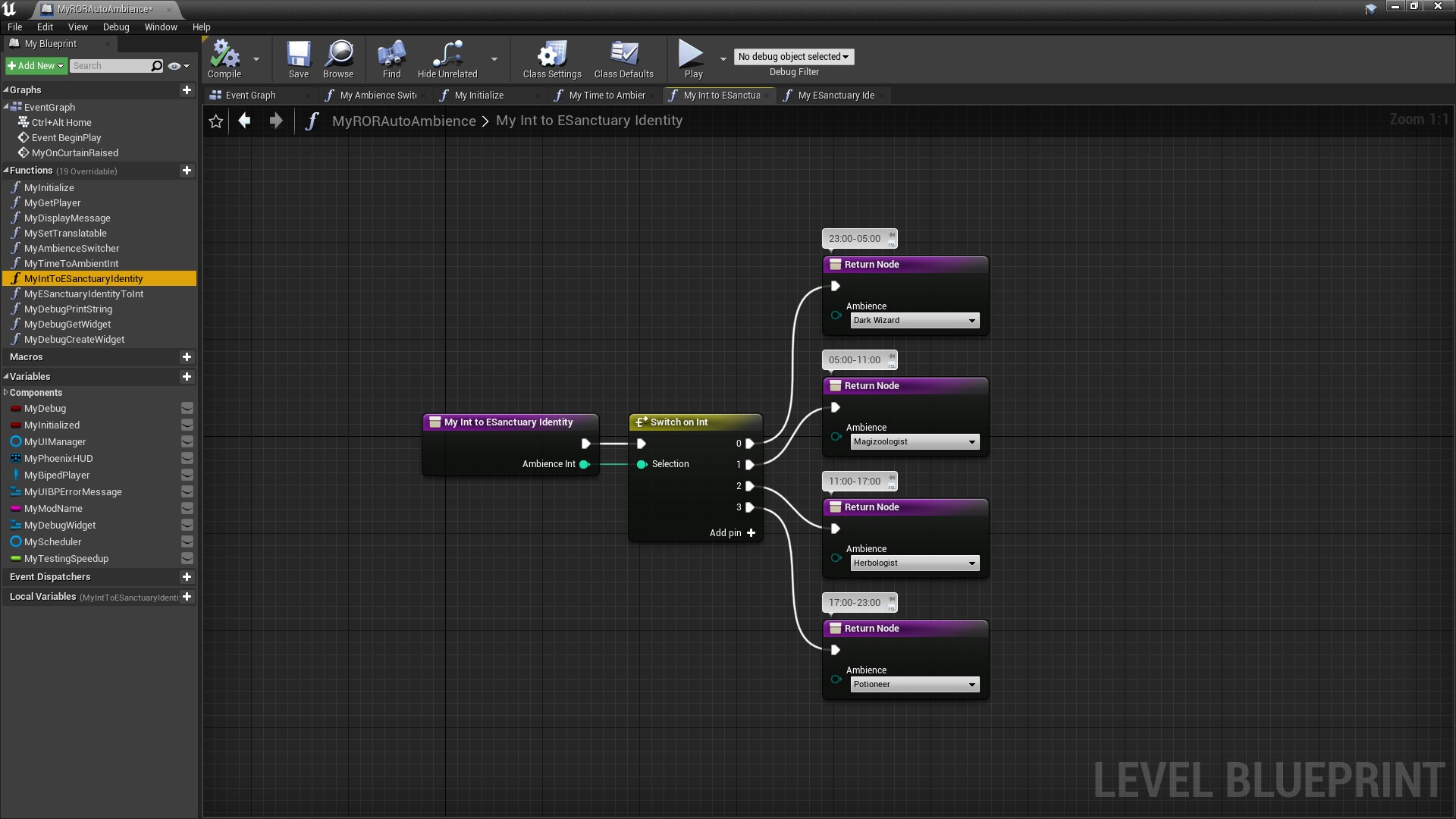¶ Synopsis
This guide presents a Room of Requirement Automatic Ambience blueprint mod for Hogwarts Legacy and describes how it works.
Beginners should read the previous tutorials before this one. They can be found here:
- Blueprint Example 101 - Hello World
- Blueprint Example 102 - Dummying Game Assets
- Blueprint Example 103 - Toggle Slow Motion
- Blueprint Example 104 - Game Pauser
- Blueprint Example 105 - HUD Toggler
- Blueprint Example 106 - Demiguise Finder
- Blueprint Example 107 - Debug Widget
- Blueprint Example 108 - Time Skip
¶ Prerequisites
All the usual prerequisites apply at this point. I won't keep repeating them.
If you're a beginner and you haven't read the previous tutorials you should. You'll struggle to follow this one if you don't.
¶ Download the Level Blueprint
You can download the Level Blueprint (.umap file) using the link below.
Remember to rename it to MyRORAutoAmbience.umap (noting the uppercase letters) and put it in PhoenixUProj\Content\CustomContent\.
Download the Level Blueprint from here.
¶ Event Graph
The Event Graph looks quite different to previous tutorials. The way this mod is going to work is as follows: as soon as the game is up and running it will called a Function called MyAmbienceSwitcher which will set the RoR ambience based on the in-game time of day. That Function will then set a timer running which will call MyAmbienceSwitcher again in 60 seconds' time. The signal that the game is “up and running” is called Curtain Raised in Unreal Engine. So our Event BeginPlay checks whether the curtain is down. If not, then the game is running and we can immediately call MyAmbienceSwitcher. But if it's down we must wait.
You might wonder why I call MyAmbienceSwitcher every 60 seconds. Game time runs 30 times faster than real time, so if the ambience changes every 6 hours of game-time that's every 12 minutes in real-time. Why not run MyAmbienceSwitcher every 12 minutes? Well, it's because the Function to change the ambience only works if you're in the RoR or fast-travelling to the RoR. Therefore, if you enter the RoR via the door, the ambience will be incorrect when you enter. It will only switch to the correct setting the next time MyAmbienceSwitcher is called. If that isn't for another 12 minutes then that's no good. But waiting a maximum of 60 seconds isn't so bad.
I have also replaced one of the Nodes in the Debug toggle logic from a simple Validated Get to a call to MyDebugGetWidget. This is a better approach because if the Validated Get failed the Debug Widget would simply not appear. Now it will attempt to create the Debug Widget before giving up.

¶ MyInitialize
There's one small change to the MyInitialize Function. I've added Get LightingIdentityMaster which we'll need later.

¶ MyAmbienceSwitcher
This Function does most of the work. It operates as follows:
- A
Sequence Nodesends execution along the upper path first, then the lower path. - On the upper path calls are made to
MyTimeToAmbientIntandMyIntToEsanctuaryIdentity, withVariablesset to remember the outputs. - A test is also performed to check whether the existing ambiance is already set to the one required. If so
MyAmbienceOkayis set toTRUE. - The lower path splits based on whether
MyAmbienceOkayisTRUEor not. - If
TRUEthen the ambience doesn't need to be set, so I just start aTimerto callMyAmbienceSwitcheragain in 60 seconds. - If
FALSEthen the ambience is changed using a gameFunctioncalledSet Identityand theTimeris set to repeat in 60 seconds. I suppose this could actually be set to 720 seconds (or 660 to be safe)… since we know that the ambience will be correct for the next 12 minutes no matter what… but I haven't thought about that so I'm not entirely sure… It's the things you don't anticipate that catch you out! - Finally, there are two parts of the graph that are currently disconnected and disabled, marked in red. The one on the right just prints some debug info so isn't very interesting. The one of the left is potentially quite useful. If this were connected to the green
In Blend Durationpin on theSet IdentityNodeit would make the ambience change gradually from one setting to the next over the course of 6 in-game hours. In other words the ambience would be constantly evolving from one to the next. Of course it's quite hard to see if this is actually working since it happens so slow. Time inside the game runs about 30 times faster than the real world, so one game-day is about 48 real-minutes. And 6 game-hours is 12 real-minutes (or 720 real-seconds). To allow you to see this slow change happen a bit faster I included aVariablecalledMyTestingSpeedup. By default this is set to1.0but if you set it to48.0then one game-day will pass in one real-minute, and 6 game-hours will pass in 15 real-seconds. So you can see things happen much more rapidly. I would also note that there is a mod called Tempus Imperium which speeds up the day-night cycle y changing an in-gameVariablecalledSiumlationTimeFactorOverridefrom1.0to some other number. I have therefore attempted to adjust for this.

¶ MyTimeToAmbientInt
This Function converts the current in-game time to an Integer in the range 0 to 3. These represent the four ambience settings. The Function works as follows:
- This is slightly weird, but for some reason the game provides the number of minutes since midnight, not the number of minutes since the previous hour. So 6:12am will be
372minutes not12minutes. I thereforeGetMinuteOfTheDayand divide it by 60 to get aFloatequivalent, with minutes as the integer part and seconds as the decimal fraction. So 6:12am will be6.20hours after midnight. - I add one hour because I found that changing the ambience at midnight, 6am, 12noon and 6pm didn't feel quite right. From late Autumn to early Spring it gets dark from about 4pm in Scotland. I adjusted the times by one hour so that the ambience changes at 11pm, 5am, 11am and 5pm.
- I multiply that by
MyTestingSpeedupto speed things up for testing (if it's set to a number >1.0). - I then
Truncatethis to get just theIntegerpart, which is the number of hours since midnight (plus one). - The I use the slightly obscure
Modulomathematical function to ensure that the results always fall within the range0to23. If our in-game time is currently 23:30, for example, this will become 24:30 after I've added an hour, which will be24inIntegerterms.Modulowill convert that24to0, which is what we want because 24:30 should actually be 00:30, so0for our purposes, not24. - Finally, I divide that by 6 so our
Integersin the range0to23becomeIntegersin the range0to3.

¶ MyIntToESanctuaryIdentity
The Set Identity Node requires us to set the ambience using an ESanctuaryIdentity Enum not an Integer so we need to convert our Integers. Here's how I did it:

¶ MyESanctuaryIdentityToInt
And here's how I change them back (for the debug info that's currently disabled):

¶ Final Thoughts
That's it!